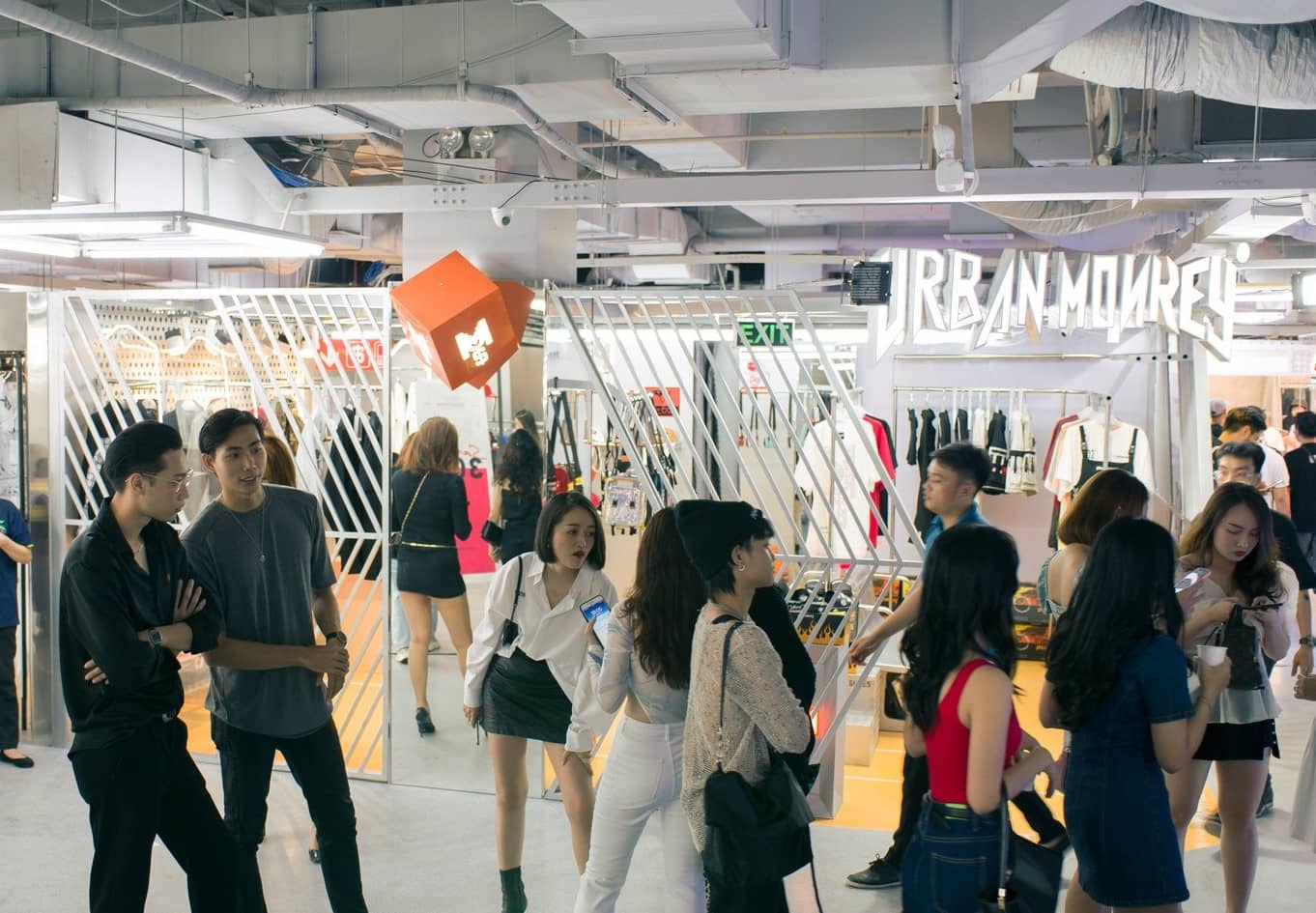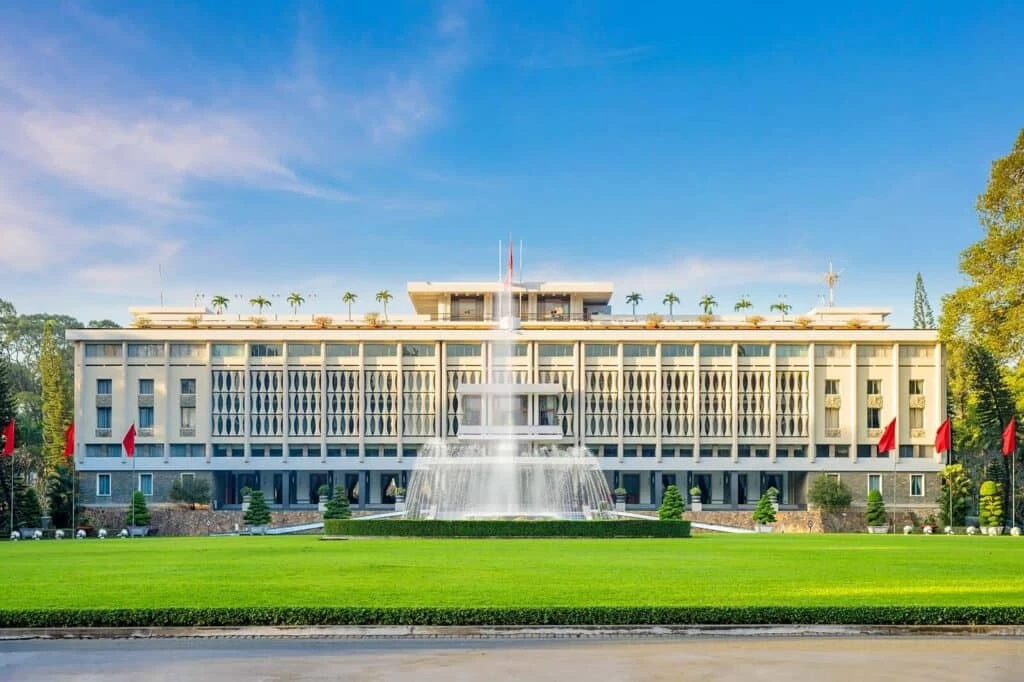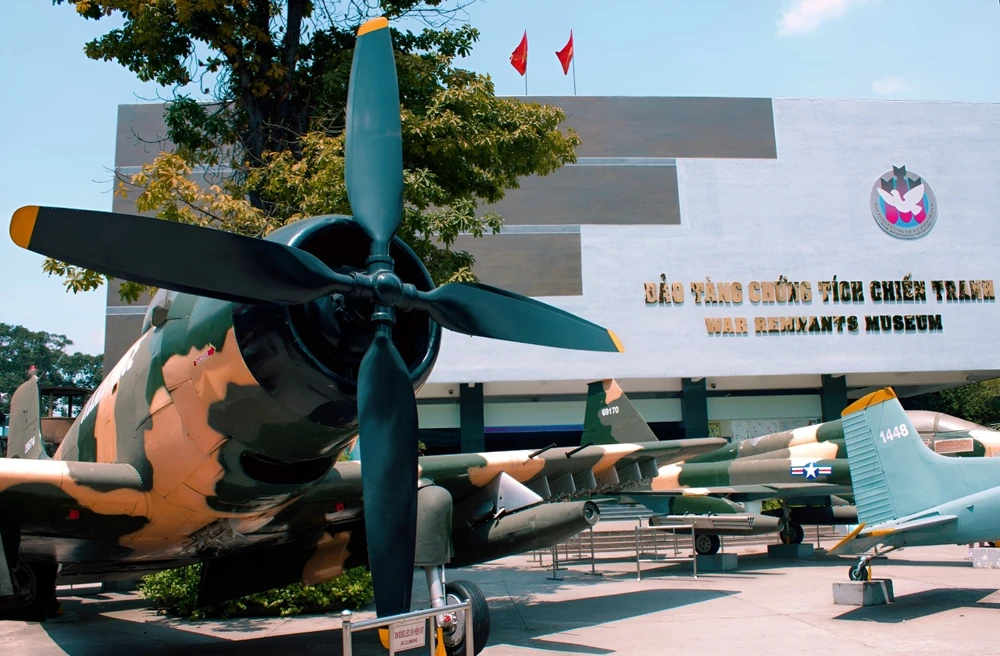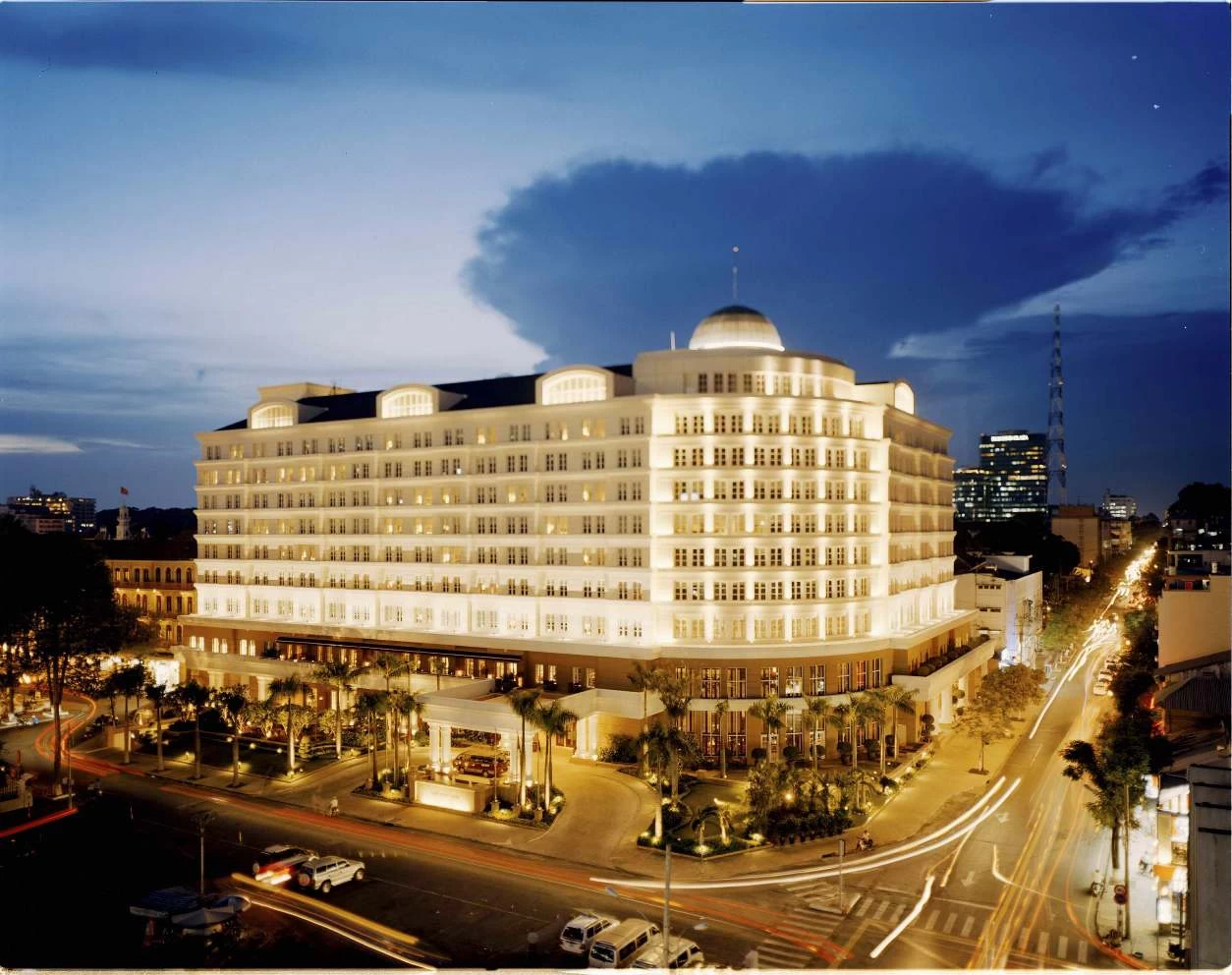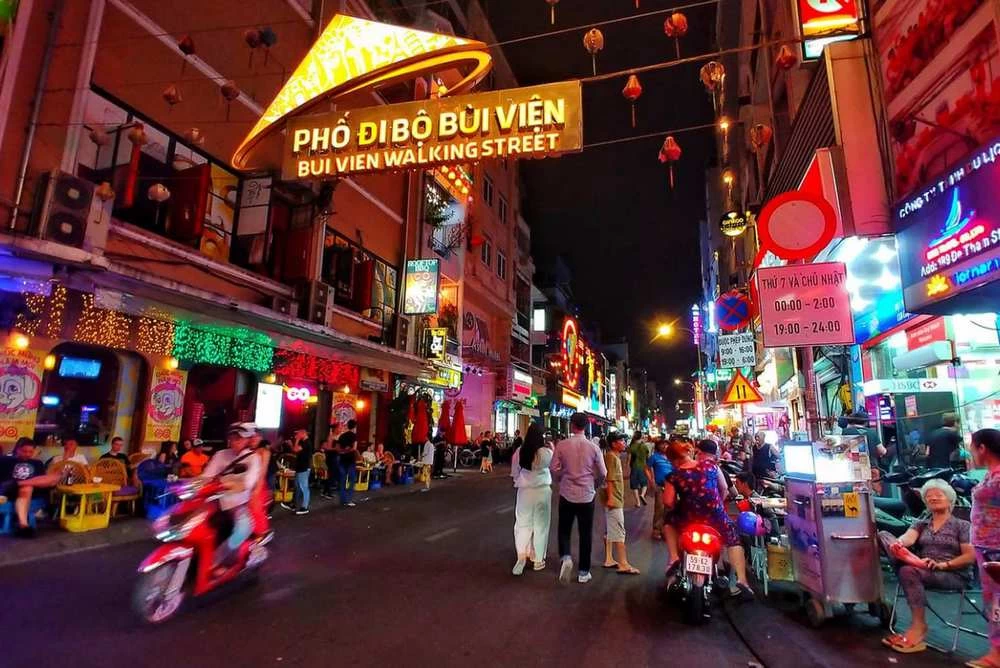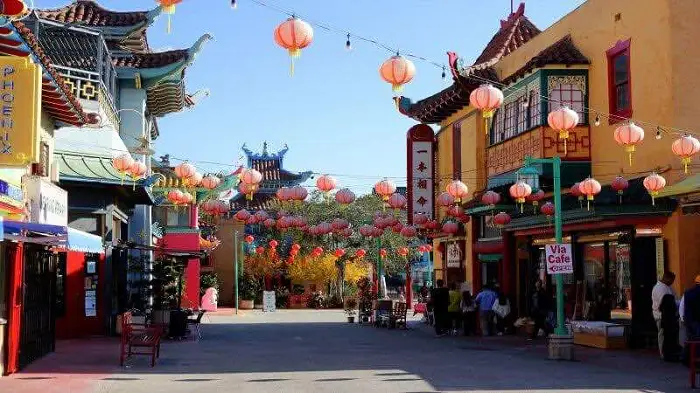
Visit a corner of China in the heart of Ho Chi Minh City
Explore the vibrant streets of Chinatown in Ho Chi Minh City, known for its rich cultural heritage, historic temples, bustling Binh Tay Market, and authentic Chinese cuisine. Discover traditional festivals, intricate architecture, and hidden gems that showcase the heart of Saigon’s Chinese community in the lively District 5. Plan your visit with Ula Travel to immerse yourself in this unique cultural enclave.
I. Introduction to Chinatown in Ho Chi Minh City
Chinatown, as it is known locally, is an expansive and vibrant Chinese district in District 5 of Ho Chi Minh City. Renowned as the largest Chinatown in Vietnam, this area offers a unique blend of rich cultural heritage, traditional architecture, bustling markets, and authentic Chinese cuisine, creating a fascinating destination for international travelers.
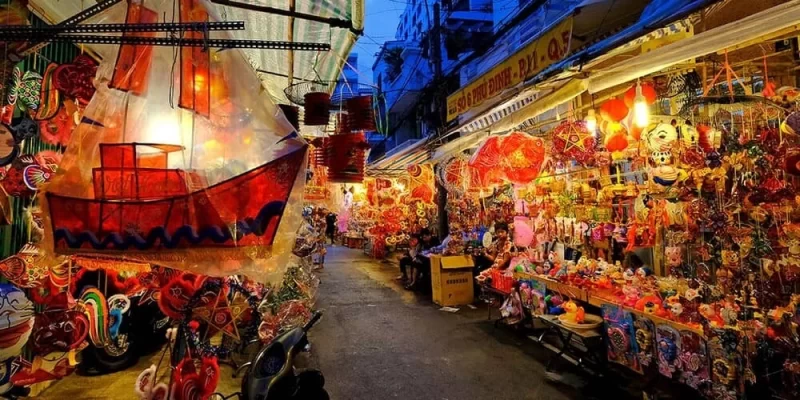
Vibrant colors at Chinatown in Ho Chi Minh City
For international travelers, Chinatown offers a rare and immersive experience. The district is home to a variety of colorful pagodas, historic temples, and traditional herbal medicine shops that reflect its enduring cultural heritage.
Visitors can also explore the renowned Binh Tay Market, where a maze of stalls overflows with local spices, traditional teas, silk, and handcrafts. Food lovers are in for a treat, with countless eateries serving up authentic dim sum, herbal soups, and other Cantonese specialties.
II. History and Culture of Chinatown in Ho Chi Minh City
1. Formation and Historical Background
The Chinatown in Ho Chi Minh City is one of the oldest and largest Chinese communities in Vietnam. This area has roots dating back to the late 18th century, when Chinese immigrants began settling in Saigon.
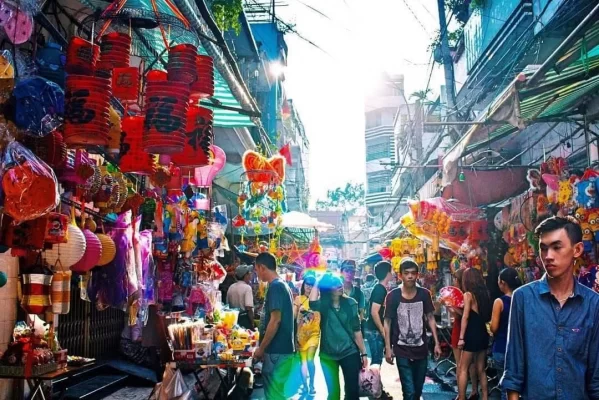
The Chinese community has a long history in Ho Chi Minh City.
The first wave of Chinese immigrants arrived primarily from the Guangdong and Fujian provinces, seeking new economic opportunities and a fresh start amidst periods of turmoil in China. Over the centuries, this district evolved into a cultural and commercial hub, rich in the traditions and heritage of the Chinese people who established it.
Chinatown became especially prominent in the 19th and early 20th centuries as the Chinese community grew in both size and influence, contributing to trade, commerce, and cultural exchanges in what was then a bustling colonial port city. The area served as a central trading post, drawing merchants and business owners from around Asia. Today, Chinatown in Ho Chi Minh City stands as a testament to the resilience and influence of the Chinese-Vietnamese, or “Hoa,” community, whose cultural imprint has profoundly shaped the identity of the district.
2. Influence from Chinese culture
The distinct cultural presence of the Chinese community is evident throughout Chinatown, from the ornate architecture to the vibrant street life filled with traditional customs. The architecture, heavily influenced by Southern Chinese designs, includes temples with dragon and phoenix motifs, intricate wooden carvings, and distinct red, gold, and green color schemes symbolic of luck, prosperity, and happiness.
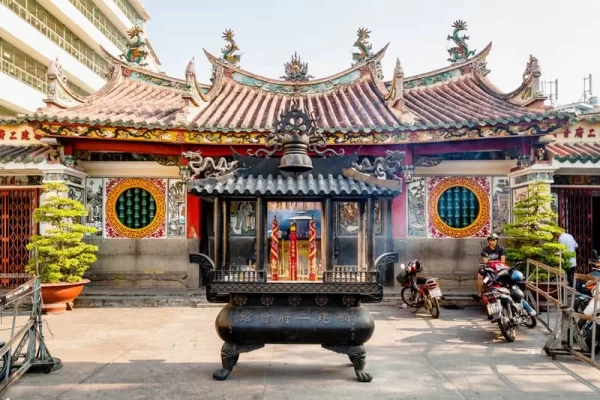
Chinese cultural colors are expressed through architectural works.
Many buildings here, including temples and ancient houses, have been meticulously preserved, showcasing a blend of Chinese and Vietnamese design elements that speak to the fusion of cultures. Chinese customs are interwoven into daily life in the area, reflecting traditional beliefs and practices. For instance, local residents continue to observe age-old rituals such as lighting incense at ancestral altars and consulting the Chinese lunar calendar for auspicious days.
Language plays a vital role in preserving the area’s cultural heritage, with Cantonese, Teochew, and Hakka still spoken among locals. Shop signs and temple inscriptions are often bilingual, written in both Vietnamese and traditional Chinese characters, highlighting the community’s deep connection to its roots.
Do not miss: Best things to do in Ho Chi Minh City
3. Heritage and Unique Festivals
Chinatown in Ho Chi Minh City is renowned for its vibrant cultural festivals that allow visitors to experience the heritage of the local Chinese-Vietnamese community firsthand. One of the most celebrated events is the Lantern Festival, or Tết Nguyên Tiêu, which occurs on the fifteenth day of the first lunar month.
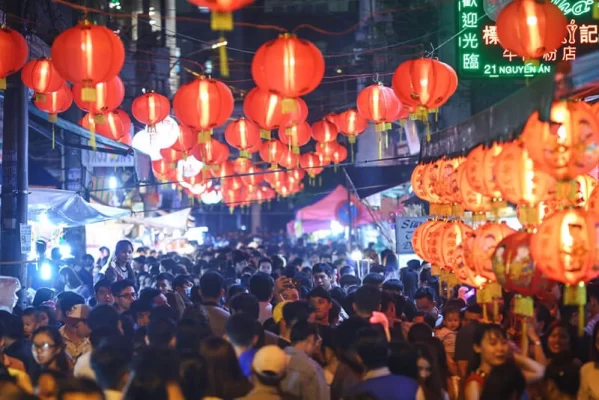
Crowded street during festival in Chinatown
Another significant festival is the Mid-Autumn Festival, celebrated on the fifteenth day of the eighth lunar month. Known for its vibrant mooncakes, colorful lanterns, and lively gatherings, the festival is a cherished time for families and communities to come together. During this time, the streets of Chinatown are filled with beautifully crafted lanterns, children’s parades, and traditional performances, creating a lively, joyous environment.
Click here: Ho Chi Minh City Tour
III. Top Attractions in Chinatown Ho Chi Minh City
1. Thien Hau Temple
Thien Hau Temple, often regarded as one of the most significant cultural landmarks in Ho Chi Minh City’s Chinatown, is dedicated to Thien Hau, the Lady of the Sea, who is believed to protect sailors and fishermen. Known for its elaborate and traditional Chinese architecture, this temple transports visitors back in time with its intricately carved woodwork, impressive altars, and large, fragrant coils of incense hanging from the ceiling.
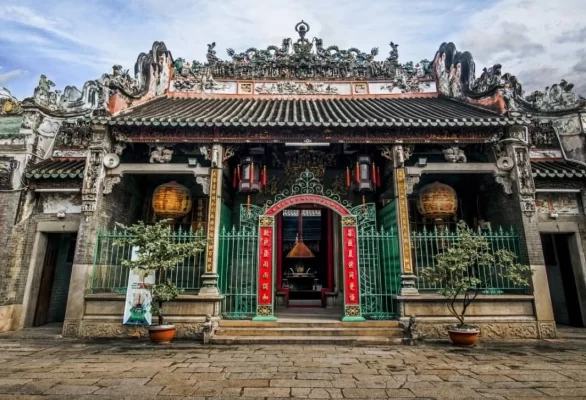
Thien Hau Temple
The temple’s courtyard and various shrines reflect deep-rooted Chinese beliefs and are adorned with porcelain dioramas, which depict historical scenes and legends. As an important spiritual site, Thien Hau Temple remains a central place for the local Chinese community to gather and offer prayers, especially during festivals like Lunar New Year and the Lantern Festival. Visitors are welcome to explore its unique atmosphere and witness how spirituality and tradition merge harmoniously here.
Learn more about: Cu Chi Tunnels Half Day Tour
2. Quan Am Pagoda
Quan Am Pagoda, dedicated to Guan Yin, the Goddess of Mercy, is another revered site in Chinatown. Known for its vibrant red-and-gold interiors and serene ambiance, the pagoda draws in both worshippers and tourists alike.
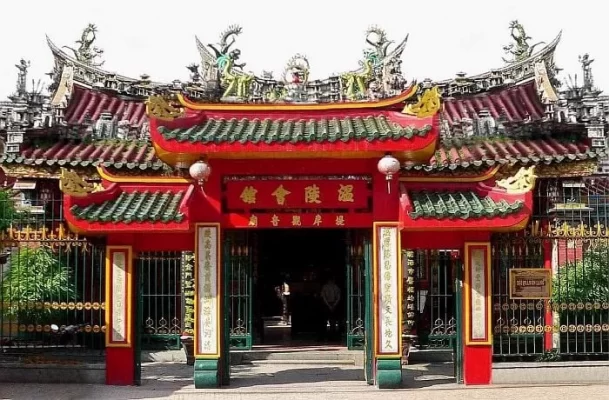
Quan Am Pagoda
The main hall houses a prominent statue of Guan Yin, surrounded by candles and offerings left by locals seeking blessings. This pagoda stands out with its traditional decorative features like dragon sculptures and intricate paintings, each symbolizing important elements of Chinese culture.
Quan Am Pagoda provides a glimpse into the lives of the Chinese-Vietnamese community and offers visitors a tranquil experience, surrounded by the sounds of chanting and the gentle aroma of incense. Its peaceful environment invites people to pause and reflect, making it a beloved cultural and spiritual spot in Chinatown.
More details: Best of Southern Vietnam
3. Binh Tay Market
Located at the heart of Chinatown, Binh Tay Market is a bustling trading hub that showcases the vibrant commercial life of Ho Chi Minh City’s Chinese community. Established in the 1920s, this market offers a variety of goods, from fresh produce and traditional Chinese herbs to handmade crafts and textiles. With its distinctive yellow façade and clock tower, Binh Tay Market reflects French colonial architectural influences blended with classic Chinese styles.
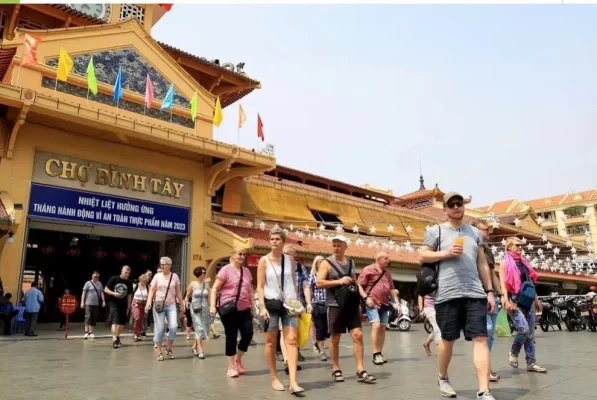
Binh Tay Market
Inside, visitors can find stalls filled with a wide array of products, including spices, teas, dried fruits, and household items. The market’s food court serves authentic Chinese-Vietnamese dishes, such as dim sum, noodles, and savory soups, giving visitors a true taste of local cuisine. Binh Tay Market is a sensory experience where travelers can explore, shop, and savor the multicultural flavors of Chinatown.
You might be like: Discover The Ho Chi Minh City to Mekong Delta Tour
IV. Chinese Cuisine in Ho Chi Minh City’s Chinatown
Chinatown in Ho Chi Minh City offers a remarkable array of traditional Chinese cuisine that attracts both locals and international visitors. This culinary hub brims with flavors and dishes rooted in generations-old recipes, showcasing the vibrant cultural heritage of the Chinese-Vietnamese community. Below are some standout dishes that truly define the food scene in this unique neighborhood.
1. Dimsum: A Bite-Sized Delight
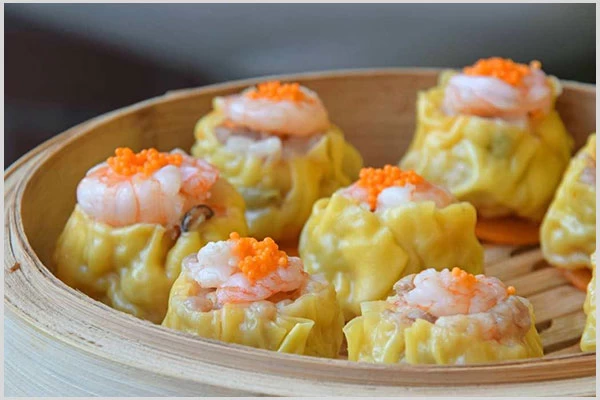
Dimsum is a traditional Chinese dish.
Dimsum is an absolute staple in Chinatown’s food offerings, loved for its variety and delicate flavors. It consists of a range of small dishes, from steamed dumplings to spring rolls and buns, each expertly crafted with an array of fillings, such as shrimp, pork, and vegetables.
You’ll find popular dimsum spots that serve these treats in steaming bamboo baskets, often with a side of soy sauce and chili paste. Enjoying dimsum here is a culinary experience itself, with locals gathering for this classic meal, typically enjoyed with a pot of hot tea.
Read more: Street food in Ho Chi Minh City
2. Mi Vit Tiem: Fragrant Herbal Duck Noodle Soup
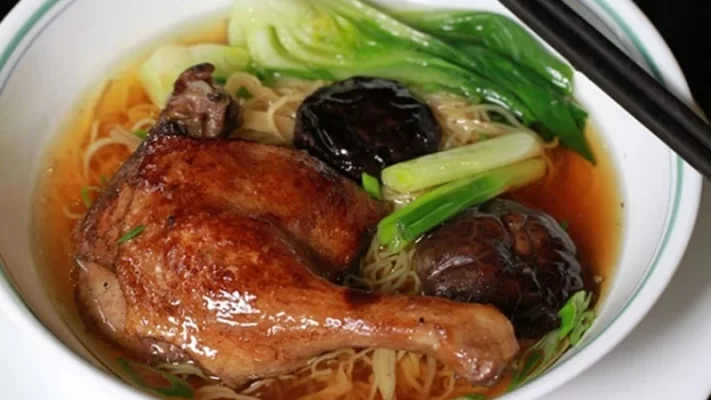
Mi Vit Tiem
Mi Vit Tiem is a beloved and unique noodle dish that brings together tender roasted duck, rich in aromatic herbs, and perfectly cooked noodles. The broth is the star of this dish, simmered with medicinal herbs, star anise, and goji berries, which give it a complex, slightly sweet flavor profile.
The duck is marinated, then roasted until its skin is golden and crispy, while the meat remains succulent. Mi Vit Tiem has a distinctly comforting taste, making it a must-try for visitors wanting to experience a dish both nourishing and packed with traditional flavors.
3. Chinese-Style Sweet Soups (Chè)
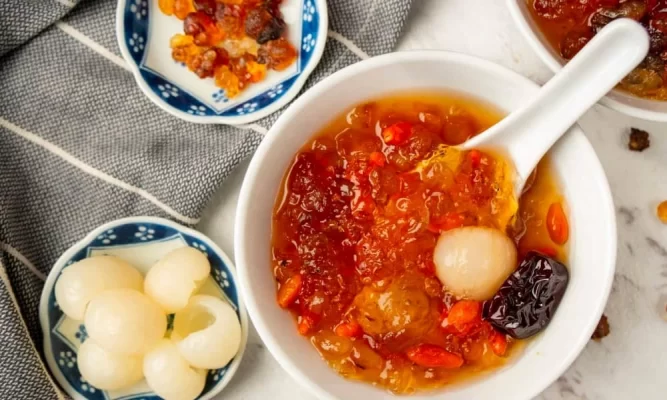
Chinese-Style Sweet Soups
Perfect for the tropical climate, chè is a popular dessert option that comes in a variety of refreshing flavors. Unlike typical Western desserts, chè combines sweet and earthy flavors, often made with ingredients like lotus seeds, mung beans, coconut milk, and tapioca pearls.
Served warm or cold, each bowl offers a taste of traditional Chinese dessert culture, with textures ranging from smooth to slightly chewy. Chè is especially enjoyable after a day of sightseeing, providing a light yet satisfying end to any meal.
4. Notable Restaurants to Experience Authentic Chinese Cuisine
- Baoz Dimsum: Known for its extensive dimsum menu, Baoz Dimsum is a local favorite. Here, you can sample traditional and modern dimsum variations, including crystal shrimp dumplings and barbecued pork buns.
- Tan Nguyen Thai Restaurant: This spot is renowned for its authentic Mi Vit Tiem. The restaurant’s hearty portions and rich broth make it popular with both locals and visitors.
- Sweet Soup Shops: Numerous small shops and street vendors around Chinatown specialize in chè, offering diverse flavors that let you explore a variety of sweet soups. Some shops even allow you to customize ingredients for a more personal experience.
V. Cultural Experiences in Ho Chi Minh’s Chinatown
Exploring Chinatown in Ho Chi Minh City offers visitors a unique chance to immerse themselves in rich Chinese cultural traditions that have been preserved and celebrated for generations. Here are some of the standout experiences:
1. Discover Handicraft Shops
- Traditional Crafts: Strolling through Chinatown’s bustling streets, visitors can explore shops selling handcrafted items steeped in Chinese heritage, such as intricate paper lanterns, traditional tea sets, and unique pottery items. These crafts often feature symbols of prosperity and health, providing insight into Chinese beliefs and aesthetics.
- Chinese Herbs and Remedies: Many shops in Chinatown also specialize in traditional Chinese herbs and medicines, from dried roots and ginseng to elaborate tonics. Visitors can learn about the medicinal properties of these ingredients, which are still widely used in Vietnamese-Chinese communities for their healing and rejuvenating qualities.
2. Visit Traditional Chinese Medicine Shops
- Experience Herbal Pharmacies: Chinatown is renowned for its traditional Chinese medicine shops, where skilled herbalists prepare and prescribe remedies for various health needs. These shops often display shelves lined with glass jars filled with herbs, dried fruits, and roots, as well as unique medicinal ingredients like sea horses and deer antlers.
- Consult with a Local Herbalist: For those interested, some herbalists may offer short consultations to explain the properties of different herbs or create custom blends based on individual wellness needs. This experience provides a fascinating look into the philosophy of balance and holistic healing that underpins traditional Chinese medicine.
3. Try Your Hand at Cultural Workshops
- Lantern-Making Classes: Several craft shops offer hands-on workshops where visitors can create their own Chinese lanterns. This activity not only serves as a fun souvenir-making opportunity but also connects participants to the tradition of lanterns in Chinese culture, which symbolize illumination and enlightenment.
- Calligraphy Lessons: A few studios in Chinatown provide beginners with the opportunity to learn Chinese calligraphy. Visitors can practice basic strokes and even write Chinese characters with guidance from skilled calligraphers. This activity provides a deeper appreciation for Chinese artistry and language.
- Chinese Culinary Classes: Some traditional eateries in the area host cooking workshops where visitors can learn to make classic Chinese treats, such as dumplings or sesame balls. These classes often include demonstrations and tasting sessions, giving participants a chance to experience the flavors and techniques that define Chinese cuisine in Vietnam.
VI. Suggested Itinerary: Half-day and Full-day Options
1. Half-day Itinerary
- Start at Thien Hau Temple (9:00 AM- 10:00 AM): Begin your visit at Thien Hau Temple, an exquisite example of traditional Chinese architecture. Spend about an hour exploring its intricate woodwork, vibrant decorations, and peaceful courtyards.
- Head to Binh Tay Market (10:15 AM–11:30 AM): Just a short walk from Thien Hau Temple, Binh Tay Market is a bustling spot to shop for local handicrafts and souvenirs and taste a variety of street food. Allocate an hour to explore the market’s maze of booths.
- Conclude with a Local Meal (11:30 AM – 12:30 PM): End your half-day visit with a meal at a nearby local restaurant. Try dim sum, roast duck, or other traditional Chinese-Vietnamese dishes to complete the experience.
2. Full-day Itinerary
- Morning at Thien Hau Temple (9:00 AM- 10:00 AM): Start your day early at Thien Hau Temple to enjoy it in a quieter setting.
- Explore Quan Am Pagoda (10:15 AM- 11:00 AM): Just a short walk away, Quan Am Pagoda offers another beautiful glimpse into local spiritual life and Chinese-influenced architecture.
- Shop and Snack at Binh Tay Market (11:15 AM – 12:30 PM): Head to Binh Tay Market to browse, snack on local specialties, and enjoy the dynamic atmosphere.
- Lunch Break (12:30 PM-1:30 PM): Stop by a recommended restaurant to try authentic Chinatown flavors.
- Walk Through Cholon (1:30 PM-3:30 PM): In the afternoon, take a leisurely stroll around Cholon, Chinatown’s main area, to admire traditional buildings, visit herbal shops, and discover interesting local stores.
- End with a Treat at a Chinese Dessert Shop (3:30 PM- 4:00 PM): Wrap up your day with a refreshing bowl of Chinese-style herbal jelly or sweet soup, popular in this part of town.
3. Tips for Visiting Chinatown in Ho Chi Minh City
- Avoid Peak Hours: Chinatown can become particularly crowded during peak times, especially in the mornings and late afternoons. For a more relaxed experience, visit mid-morning or early afternoon.
- Visit During Festivals for a Unique Experience: If possible, plan your visit around major festivals such as Lunar New Year or the Mid-Autumn Festival to witness traditional lion dances, colorful lanterns, and vibrant local celebrations.
- Wear comfortable footwear: Chinatown’s main attractions are best explored on foot, and comfortable shoes will help you navigate the bustling markets and temple grounds with ease.
- Be mindful of personal belongings: Like many crowded areas, Chinatown is busy and lively. Keep an eye on your belongings, especially in markets and crowded streets, to ensure a smooth and safe experience.
In conclusion, Chinatown in Ho Chi Minh City is a vibrant blend of history, culture, and cuisine that offers travelers a unique window into the city’s rich heritage. From ornate temples and bustling markets to authentic Chinese-Vietnamese dishes, this lively district encapsulates the diverse spirit of Ho Chi Minh. A visit to Chinatown is a must for those looking to experience the city’s cultural depth and dynamic atmosphere firsthand.
See more: Ho Chi Minh City Travel Tips



